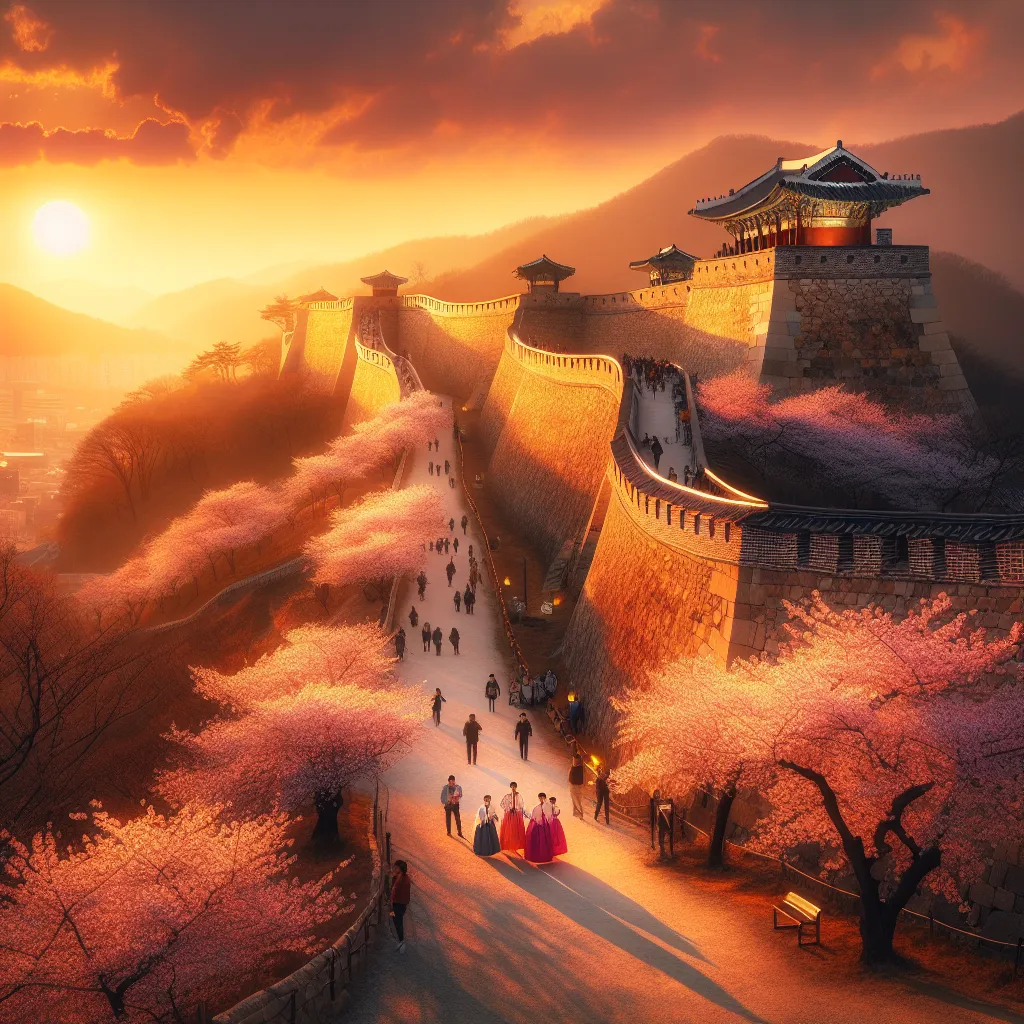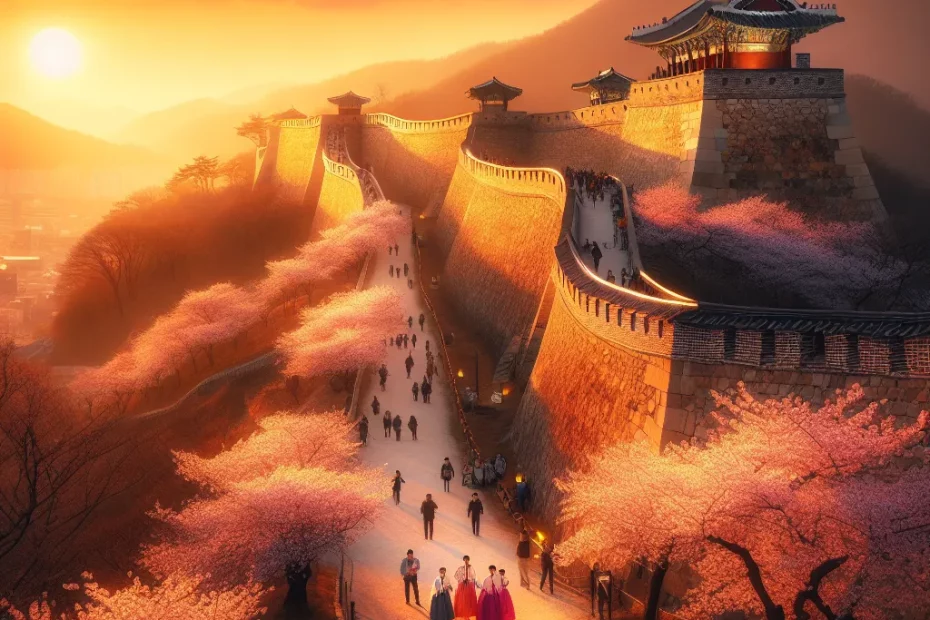In the heart of Suwon lies a historical gem that has stood the test of time – Hwaseong Fortress. This magnificent fortress holds a significant place in Korean history, showcasing the architectural brilliance and strategic foresight of its builders. As we delve into the construction process, layout, cultural impact, and restoration efforts of Hwaseong Fortress, we uncover a tapestry of stories that intertwine with the rich heritage of South Korea. Join me on a journey to explore the depths of this iconic structure and unravel the layers of history that have shaped its legacy.

Discovering the Construction Process of Hwaseong Fortress
In exploring the historic significance of Hwaseong Fortress in Suwon, one cannot overlook the meticulous construction process that took place centuries ago. This architectural marvel, built during the late 18th century, stands as a testament to the ingenuity and craftsmanship of the Joseon Dynasty. 🏰
The Beginnings of Hwaseong Fortress
The construction of Hwaseong Fortress began in 1794 under the order of King Jeongjo, with the aim of honoring and housing the remains of his father, Crown Prince Sado. The fortress was designed to serve both practical and symbolic purposes, showcasing the military prowess of the dynasty while also embodying Confucian principles of filial piety and respect for ancestors. 🛠️
The Engineering Marvel
To realize this grand vision, over 7 kilometers of walls were meticulously planned and constructed, incorporating various defensive features such as bastions, artillery towers, and gateways. The use of advanced engineering techniques, including the innovative ‘Geojunggi’ method of leveling the walls, demonstrated the sophisticated knowledge and skills of the architects and laborers involved in the project. 🏗️
The Labor and Dedication
The construction process was a massive undertaking, requiring the labor of thousands of workers and the coordination of skilled craftsmen from across the kingdom. Stones were quarried from nearby mountains, each one carefully shaped and fitted into place to ensure the structural integrity of the fortress. The sheer scale of the project is awe-inspiring, with an estimated 1.3 million laborers contributing to its completion over a period of approximately 4 years. 🌄
The Enduring Legacy
As one wanders through the corridors and ramparts of Hwaseong Fortress today, it is impossible not to marvel at the sheer dedication and artistry that went into its construction. The fortress stands not only as a physical monument to Korea’s rich history but also as a symbol of the enduring legacy of the Joseon Dynasty. 🌟
In conclusion, the construction process of Hwaseong Fortress is a remarkable feat of engineering and artistry, showcasing the skills and dedication of the craftsmen and laborers of the Joseon Dynasty. It serves as a lasting reminder of Korea’s cultural heritage and continues to captivate visitors from around the world with its beauty and historical significance. 🌏
Unveiling the Strategic Layout of Hwaseong Fortress
Welcome to a journey through time as we delve into the strategic layout of the magnificent Hwaseong Fortress in Suwon. Built in the late 18th century by King Jeongjo of the Joseon Dynasty, this UNESCO World Heritage Site stands as a testament to the military brilliance and architectural ingenuity of the era. Let’s unravel the secrets of its design and layout that made it a formidable stronghold.
The Impressive Features
The fortress spans over 5.7 kilometers and is adorned with impressive features such as four main gates, various command posts, beacon towers, and artillery towers strategically placed along its walls. The intricate network of walls, bastions, and gates was meticulously planned to defend against external threats and ensure the safety of the kingdom.
Harmonizing with the Landscape
One of the key elements of the fortress’s layout is its use of geomancy, or the traditional Korean practice of harmonizing with the surrounding landscape for strategic advantage. The alignment of the walls and gates with the natural topography not only enhanced the fortress’s defensive capabilities but also created a visually stunning architectural masterpiece.
Key Structures
As we wander through the fortress, we come across the Paldalmun Gate, the main southern entrance, which boasts a double-roofed pavilion and intricate wooden carvings. Moving along the walls, we encounter the Hwaseomun Gate to the west, strategically positioned to overlook the surrounding plains and provide a vantage point for surveillance.
The artillery towers, known as Seojangdae and Dongjangdae, were strategically located to provide clear lines of sight for defending against enemy attacks. These towers housed cannons and firearms, ready to repel any invaders daring to challenge the might of the fortress.
Defensive Features
The Suwoncheon Stream, flowing around the fortress, served as a natural moat, further enhancing its defensive capabilities. The combination of natural barriers and man-made fortifications made Hwaseong Fortress an impregnable stronghold, instilling fear in the hearts of any would-be attackers.
As we conclude our exploration of the strategic layout of Hwaseong Fortress, we are left in awe of the meticulous planning and architectural brilliance that went into its construction. The fortress stands as a living testament to Korea’s rich history and the enduring legacy of King Jeongjo’s vision for a stronghold that would withstand the test of time.
In conclusion, Hwaseong Fortress in Suwon is not just a historic site but a marvel of military engineering and architectural design. Its strategic layout, blending seamlessly with the natural landscape, showcases the genius of its creators and continues to captivate visitors from around the world. Plan your visit to this cultural gem and immerse yourself in the grandeur of Korea’s past! 🏰🌿
Exploring the Cultural Impact of Hwaseong Fortress
In the heart of Suwon, South Korea, stands the magnificent Hwaseong Fortress, a UNESCO World Heritage Site that bears witness to the rich cultural history of the region. Built in the late 18th century by King Jeongjo of the Joseon Dynasty, this architectural marvel not only served as a defensive structure but also played a pivotal role in shaping the cultural landscape of the area.
Historical Significance
Hwaseong Fortress was constructed with meticulous attention to detail, incorporating both traditional Korean architectural elements and innovative features influenced by Western military technology of the time. The fortress walls, stretching over 5.7 kilometers, are adorned with stunning pavilions, gates, and command posts, reflecting the artistic and engineering prowess of the Joseon craftsmen.
Cultural Influence
Beyond its military function, Hwaseong Fortress became a hub of cultural exchange and artistic expression. The fortress served as a center for academic activities, attracting scholars and intellectuals who engaged in discussions on various subjects ranging from Confucianism to astronomy. The vibrant cultural scene within the fortress walls fostered creativity and innovation, leaving a lasting impact on the artistic heritage of Suwon.
Performing Arts
One of the most notable cultural contributions of Hwaseong Fortress is its association with traditional Korean performing arts. The spacious courtyards and grand halls within the fortress provided the perfect stage for performances of court music, dance, and rituals. These artistic displays not only entertained the residents of Suwon but also preserved and promoted Korea’s cultural heritage for future generations.
Cultural Festivals
To this day, Hwaseong Fortress continues to be a vibrant cultural center, hosting various festivals and events that celebrate the traditions and history of Korea. From colorful lantern festivals to traditional music concerts, the fortress grounds come alive with the spirit of cultural appreciation, attracting visitors from near and far to partake in the festivities.
Legacy and Preservation
As a symbol of Korea’s cultural identity, Hwaseong Fortress stands as a testament to the ingenuity and creativity of the Joseon Dynasty. Efforts to preserve and maintain this cultural treasure ensure that future generations can continue to explore and appreciate the rich heritage embodied by the fortress.
In conclusion, the cultural impact of Hwaseong Fortress in Suwon transcends its historical significance, serving as a living testament to the artistic, intellectual, and social achievements of the past. This iconic landmark continues to inspire and captivate visitors, inviting them to delve into the vibrant tapestry of Korean culture woven within its ancient walls.
Investigating the Restoration Efforts of Hwaseong Fortress
Welcome to a fascinating journey through the restoration efforts of Hwaseong Fortress in Suwon! 🏰
The Historical Significance
Hwaseong Fortress, a UNESCO World Heritage site, stands as a testament to Korea’s rich history and architectural brilliance. The fortress, built in the late 18th century by King Jeongjo of the Joseon Dynasty, has undergone various restoration projects over the years to preserve its cultural significance and grandeur. 🌟
The Restoration Process
The meticulous restoration efforts of Hwaseong Fortress have been a labor of love, combining traditional craftsmanship with modern techniques. The restoration team, comprised of skilled artisans and historians, has worked tirelessly to ensure that every stone, brick, and tile is restored to its original glory. 🛠️
The Use of Technology
Through the use of advanced technology such as 3D scanning and historical research, the restoration team has been able to recreate intricate architectural details that were lost to time. This attention to detail not only preserves the historical accuracy of the fortress but also provides valuable insights into the craftsmanship of the past. 🔍
The Emphasis on Authenticity
One of the most remarkable aspects of the restoration efforts is the commitment to using authentic materials and techniques. From sourcing traditional clay for roof tiles to employing age-old masonry methods, every step is taken to honor the craftsmanship of the original builders. 🧱
The Cultural Heritage
The restoration of Hwaseong Fortress is not just about preserving a historical site; it is a celebration of Korea’s cultural heritage and a tribute to the generations of artisans who have contributed to its beauty. The fortress stands as a living monument to the past, inviting visitors to step back in time and experience the grandeur of Korea’s architectural legacy. 🌿
The Importance of Preservation
As we delve deeper into the restoration efforts of Hwaseong Fortress, we are reminded of the importance of preserving our cultural heritage for future generations. The dedication and passion of those involved in the restoration serve as a beacon of hope, inspiring us to cherish and protect the treasures of our past. 💖
The Enduring Spirit
In conclusion, the restoration efforts of Hwaseong Fortress are not just about rebuilding walls and gates; they are a testament to the enduring spirit of preservation and a tribute to the timeless beauty of Korean architecture. Let us continue to support and celebrate these efforts, ensuring that the legacy of Hwaseong Fortress shines brightly for centuries to come. ✨
In conclusion, the exploration of Hwaseong Fortress in Suwon reveals not only its historical significance but also its cultural impact and strategic layout. The construction process and restoration efforts shed light on the dedication and craftsmanship of the past. By delving into the fortress’s history, we gain a deeper appreciation for its role in Korean heritage and its enduring legacy. As a symbol of innovation and resilience, Hwaseong Fortress stands as a testament to the rich history of Suwon and the ingenuity of its creators. Through continued preservation and study, we can ensure that this remarkable site continues to inspire and educate future generations about Korea’s vibrant past.
